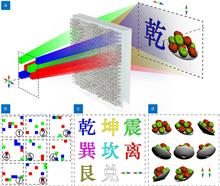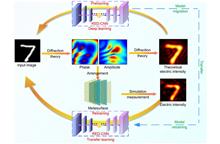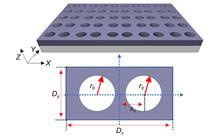 View fulltext
View fulltext
Color metasurface holograms are powerful and versatile platforms for modulating the amplitude, phase, polarization, and other properties of light at multiple operating wavelengths. However, the current color metasurface holography can only realize static manipulation. In this study, we propose and demonstrate a multiplexing metasurface technique combined with multiwavelength code-division multiplexing (CDM) to realize dynamic manipulation. Multicolor code references are utilized to record information within a single metasurface and increase the information capacity and security for anti-cracks. A total of 48 monochrome images consisting of pure color characters and multilevel color video frames were reconstructed in dual polarization channels of the birefringent metasurface to exhibit high information density, and a video was displayed via sequential illumination of the corresponding code patterns to verify the ability of dynamic manipulation. Our approach demonstrates significant application potential in optical data storage, optical encryption, multiwavelength-versatile diffractive optical elements, and stimulated emission depletion microscopy.
As a promising counterpart of two-dimensional metamaterials, metasurfaces enable to arbitrarily control the wavefront of light at subwavelength scale and hold promise for planar holography and applicable multiplexing devices. Nevertheless, the degrees of freedom (DoF) to orthogonally multiplex data have been almost exhausted. Compared with state-of-the-art methods that extensively employ the orthogonal basis such as wavelength, polarization or orbital angular momentum, we propose an unprecedented method of peristrophic multiplexing by combining the spatial frequency orthogonality with the subwavelength detour phase principle. The orthogonal relationship between the spatial frequency of incident light and the locally shifted building blocks of metasurfaces can be regarded as an additional DoF. We experimentally demonstrate the viability of the multiplexed holograms. Moreover, this newly-explored orthogonality is compatible with conventional DoFs. Our findings will contribute to the development of multiplexing metasurfaces and provide a novel solution to nanophotonics, such as large-capacity chip-scale devices and highly integrated communication.
Complex-amplitude holographic metasurfaces (CAHMs) with the flexibility in modulating phase and amplitude profiles have been used to manipulate the propagation of wavefront with an unprecedented level, leading to higher image-reconstruction quality compared with their natural counterparts. However, prevailing design methods of CAHMs are based on Huygens-Fresnel theory, meta-atom optimization, numerical simulation and experimental verification, which results in a consumption of computing resources. Here, we applied residual encoder-decoder convolutional neural network to directly map the electric field distributions and input images for monolithic metasurface design. A pretrained network is firstly trained by the electric field distributions calculated by diffraction theory, which is subsequently migrated as transfer learning framework to map the simulated electric field distributions and input images. The training results show that the normalized mean pixel error is about 3% on dataset. As verification, the metasurface prototypes are fabricated, simulated and measured. The reconstructed electric field of reverse-engineered metasurface exhibits high similarity to the target electric field, which demonstrates the effectiveness of our design. Encouragingly, this work provides a monolithic field-to-pattern design method for CAHMs, which paves a new route for the direct reconstruction of metasurfaces.
Dielectric metasurfaces play an increasingly important role in enhancing optical nonlinear generations owing to their ability to support strong light-matter interactions based on Mie-type multipolar resonances. Compared to metasurfaces composed of the periodic arrangement of nanoparticles, inverse, so-called, membrane metasurfaces offer unique possibilities for supporting multipolar resonances, while maintaining small unit cell size, large mode volume and high field enhancement for enhancing nonlinear frequency conversion. Here, we theoretically and experimentally investigate the formation of bound states in the continuum (BICs) from silicon dimer-hole membrane metasurfaces. We demonstrate that our BIC-formed resonance features a strong and tailorable electric near-field confinement inside the silicon membrane films. Furthermore, we show that by tuning the gap between the holes, one can open a leaky channel to transform these regular BICs into quasi-BICs, which can be excited directly under normal plane wave incidence. To prove the capabilities of such metasurfaces, we demonstrate the conversion of an infrared image to the visible range, based on the Third-harmonic generation (THG) process with the resonant membrane metasurfaces. Our results suggest a new paradigm for realising efficient nonlinear photonics metadevices and hold promise for extending the applications of nonlinear structuring surfaces to new types of all-optical near-infrared imaging technologies.
Metasurface-based polarimetry techniques have attracted lots of interests and been extensively studied in the past years, but are still hampered by narrow operating bandwidth and large crosstalk. Recently, Xian-Gang Luo's group proposed a new method of polarization-dependent phase optimization for the design of crosstalk-free, broadband achromatic, and full Stokes imaging polarimeter, which offers a promising platform for a wide range of applications including bio-photonics and integrated optics.
Dielectric metasurfaces are crucial for enhancing optical nonlinear generation, particularly membrane metasurfaces with multipolar resonances and compact size. Investigating silicon dimer-hole membrane metasurfaces, Rahmani, and Xu show how bound states in the continuum (BICs) can be formed and transformed into quasi-BICs by adjusting hole gaps. This innovation enables efficient conversion of infrared images to visible range, promising applications in nonlinear photonics and near-infrared imaging technologies.














